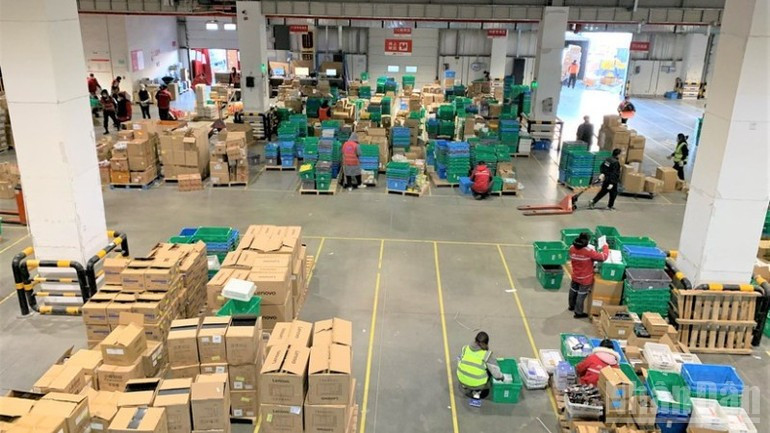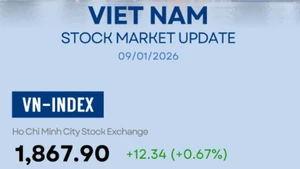Potential and competitive advantages of Viet Nam
In 2024, the retail e-commerce market in Viet Nam reached more than 25 billion USD, up over 20% compared to the previous year, accounting for about 9% of the country’s total retail sales of goods and consumer service revenue.
According to Lai Viet Anh, Deputy Director of the E-commerce and Digital Economy Agency undere the Ministry of Industry and Trade, e-commerce is not only a driver of growth but also a solid foundation for breakthroughs in the national digital economy.
The growing presence of Vietnamese goods on international e-commerce platforms has opened up great opportunities to diversify export markets, strengthen resilience against global fluctuations, and enhance the value of the national brand.
Lai Viet Anh also emphasised that digital technology is an important lever for the development of e-commerce. The application of technologies such as AI, Big Data, and IoT will help enterprises optimise operations, reduce costs, analyse market trends accurately, and build intelligent access strategies, thereby improving product quality to meet the stringent requirements of international markets.
Sharing the same view, Nick Chai, Chairman of ACBC Malaysia, said that Viet Nam has many advantages to become the region’s cross-border e-commerce hub thanks to its strategic geographical location, abundant supply of goods, young population, and strong government support. This is seen as a “springboard” for Vietnamese enterprises to make breakthroughs and increase international competitiveness.
From an international perspective, Xiao Qiuli, General Director of Guangdong Global Shopping E-commerce Co., Ltd. (GGBingo), stated that Viet Nam is facing a major opportunity to accelerate exports thanks to the multi-channel e-commerce model.

Citing China’s experience, which achieved 2.71 trillion CNY in cross-border e-commerce trade turnover in 2024 thanks to logistics development, bonded warehouses, and modern technology platforms, he said Vietnamese enterprises could adopt this model to quickly enhance global competitiveness.
Xiao Qiuli stressed that market diversification is key, not only focusing on the US or China but also expanding into ASEAN, the Middle East, Africa, and Latin America.
At the same time, the shift from Original Equipment Manufacturer (OEM) to Direct-to-Consumers (D2C) to build the “Made in Vietnam” brand, combined with effective use of channels such as Amazon, TikTok Shop, Lazada, Shopee, and JD.com will help increase coverage and optimise revenue.
In particular, investment in international logistics along with training human resources in cross-border e-commerce will be the foundation to help Vietnamese goods reach further and participate more deeply in global supply chains.
Taking Vietnamese goods “global”
This viewpoint is also shared by many domestic experts. Vu Xuan Linh, Director of Strategic Partnership Relations (Viet Nam) of SEA Group, Singapore, affirmed that the ASEAN market is the “digital frontier” for small businesses, cooperatives, and households to engage in cross-border e-commerce.
ASEAN is currently Viet Nam’s fourth largest export market, with turnover reaching 32 billion USD in 2023, and is forecast to have an e-commerce scale of 330 billion USD by 2025. This is not only a dynamic region with increasing purchasing power but also a proven destination for Vietnamese goods, especially in key markets such as Singapore, Thailand, and Malaysia.
ASEAN is currently Viet Nam’s fourth largest export market, with turnover reaching 32 billion USD in 2023, and is forecast to have an e-commerce scale of 330 billion USD by 2025.
Through programmes such as the Shopee International Platform (SIP), more than 350,000 SMEs have participated in online exports, leveraging integrated logistics, payment, and customer care ecosystems to “sit in one place – sell globally.”
Value-added services such as automatic translation, product display optimisation, goods catalogue management, and local-language customer care have significantly reduced barriers to regional expansion.
Miss Linh, an e-commerce platform founded by a Vietnamese expatriate in the Netherlands, is supporting more than 25 Vietnamese brands to export into the European market via e-commerce. Despite still being small in scale, it has achieved remarkable results and is attracting much attention from Vietnamese enterprises.
Nga Dang, founder of Viet Nam Food Europe B.V. in the Netherlands, stressed the importance of ensuring that Vietnamese products meet the strict standards of the European market to affirm the position of the Vietnamese brand.
Vo Thanh Tong, Senior Account Manager of Amazon Global Selling Viet Nam, also noted that since 2019, Amazon Global Selling has accompanied thousands of Vietnamese enterprises, helping the number of products sold increase by 300% and the number of internationally registered brands grow more than 35 times. The trend of shifting from OEM to D2C, leveraging logistics and digital tools on platforms, is being emphasised to help Vietnamese goods “take off” globally.
In addition, digital technology also plays an important role. Phi Anh Tuan, Vice President of the Ho Chi Minh City Computer Association, stressed that technology is the key lever to enhance competitiveness of enterprises in the digital era. In the context of rapid technological development and increasingly fierce competition, especially for small and medium-sized enterprises, digital transformation is considered the “key to survival.”
According to Tuan, although enterprises face many challenges such as inefficient operations, high costs, pressure from digital transformation, and rising demand for “Clean-Green” standards, a comprehensive approach centred around three pillars - People, Data & Processes, and Technology - while strengthening IT capacity is essential.


![[Video] Seven inspection teams formed to stabilise market during peak Tet period](https://en-cdn.nhandan.vn/images/9f233ae74386156ace55673ec5a8ea373e7bb5df2274800bfd51bda6ec86d9464d289201deda54c246314a974e2f0aef0bc69929884e4c53fd4eb6a1f98b468f6ae70becd9f49b834a8b9195e077c25b/anhminhhoavideo-110126-2.jpg.webp)













